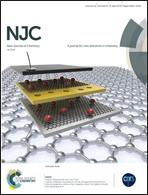Bis(formylpyrrolyl) cobalt complexes as mediators in the reversible-deactivation radical polymerization of styrene and methyl methacrylate†
Abstract
The combination of [Co(II){κ2N,O-NC4H3-C(H)![[double bond, length as m-dash]](https://www.rsc.org/images/entities/char_e001.gif) O}2(PMe3)2] (1) and tert-butyl-α-bromoisobutyrate (tBiB-Br) is a suitable initiation system for controlling the radical polymerization of styrene, by an atom transfer radical polymerization (ATRP) mechanism, below 70 °C and of methyl methacrylate, by an organometallic mediated radical polymerization (OMRP)/catalytic chain transfer (CCT) interplay mechanism, below 50 °C. The pure ATRP nature of styrene polymerization allowed the synthesis of the polystyrene-b-poly(methyl methacrylate) block copolymer, as confirmed by GPC/SEC and DOSY NMR studies. Attempts to isolate a Co(III) species containing a Br atom (Co(III)–Br), supposedly a key ATRP deactivator, by reacting 1 and tBiB-Br quantitatively afforded the cationic Co(III) complex [Co(III){κ2N,O-NC4H3-C(H)
O}2(PMe3)2] (1) and tert-butyl-α-bromoisobutyrate (tBiB-Br) is a suitable initiation system for controlling the radical polymerization of styrene, by an atom transfer radical polymerization (ATRP) mechanism, below 70 °C and of methyl methacrylate, by an organometallic mediated radical polymerization (OMRP)/catalytic chain transfer (CCT) interplay mechanism, below 50 °C. The pure ATRP nature of styrene polymerization allowed the synthesis of the polystyrene-b-poly(methyl methacrylate) block copolymer, as confirmed by GPC/SEC and DOSY NMR studies. Attempts to isolate a Co(III) species containing a Br atom (Co(III)–Br), supposedly a key ATRP deactivator, by reacting 1 and tBiB-Br quantitatively afforded the cationic Co(III) complex [Co(III){κ2N,O-NC4H3-C(H)![[double bond, length as m-dash]](https://www.rsc.org/images/entities/char_e001.gif) O}2(PMe3)2]Br (2). Metathetic exchange reactions of complex 2 with TlX gave rise to analogues of the type [Co(III){κ2N,O-NC4H3-C(H)
O}2(PMe3)2]Br (2). Metathetic exchange reactions of complex 2 with TlX gave rise to analogues of the type [Co(III){κ2N,O-NC4H3-C(H)![[double bond, length as m-dash]](https://www.rsc.org/images/entities/char_e001.gif) O}2(PMe3)2]X (3a, X = BF4−; 3b, X = BPh4−), containing non-coordinating anions. In the absence of a radical initiator, complex 2 mediated the formation of polystyrene and poly(methyl methacrylate), with poor control, likely via a generation of activators by a monomer addition (GAMA) mechanism. Complexes 3a and 3b, however, have been shown to be completely inactive. Addition of 0.5 equivalents of AIBN to 2 drastically improved the molecular weight control in the polymerization of styrene, at 70 °C, through a reverse-ATRP mechanism.
O}2(PMe3)2]X (3a, X = BF4−; 3b, X = BPh4−), containing non-coordinating anions. In the absence of a radical initiator, complex 2 mediated the formation of polystyrene and poly(methyl methacrylate), with poor control, likely via a generation of activators by a monomer addition (GAMA) mechanism. Complexes 3a and 3b, however, have been shown to be completely inactive. Addition of 0.5 equivalents of AIBN to 2 drastically improved the molecular weight control in the polymerization of styrene, at 70 °C, through a reverse-ATRP mechanism.



 Please wait while we load your content...
Please wait while we load your content...